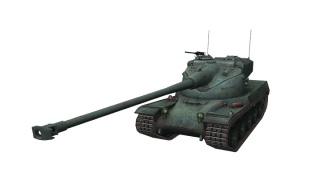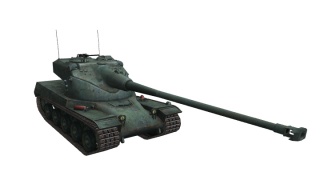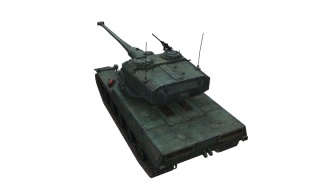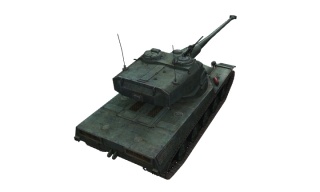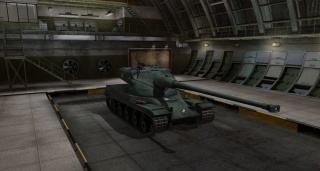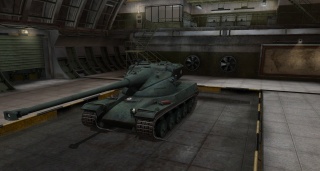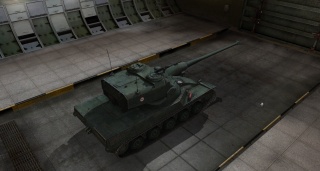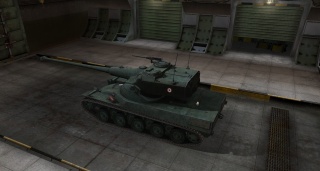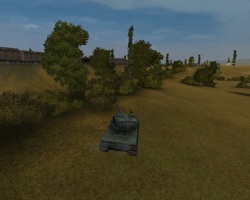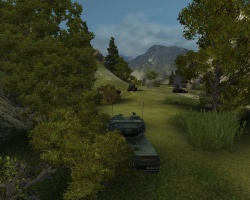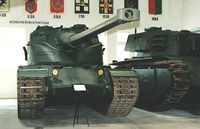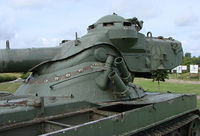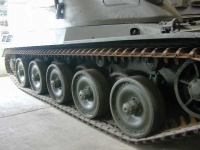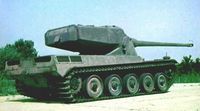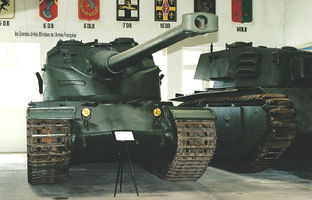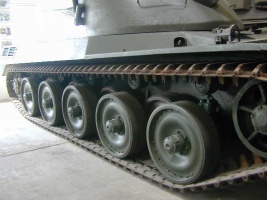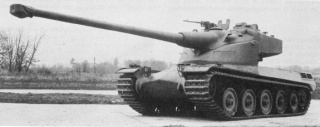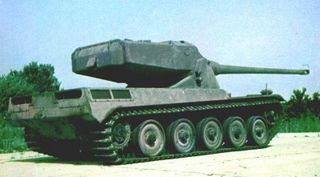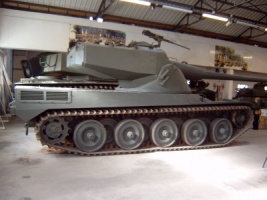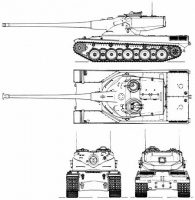AMX 50 B
AMX 50 B
Survoller à la sourie "
[Valeurs du jeu; Valeurs actuelles
- Commandant (Chargeur)
- Tireur (Chargeur)
- Pilote de char
- Opérateur radio (Chargeur)
Statistiques supplémentaires
(Char Full)
Camouflage
- A l'arrêt : 4%
- En mouvement : 2.3%
- En tirant : 0.9%
Résistance au terrain
- Sur sol dur : 1.25
- Sur sol normal : 1.34
- Sur sol mou : 2.21
Changements de valeurs liés à la dispersion
- Lié à la tourelle
- Rotation : 0.1
- Recul lié au tir : 3.84
- Lié à la suspension
- Accélération : 0.17
- Rotation : 0.17
Avec un équipage à 100%
X
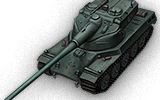
6100000
Le AMX 50 B est un char lourd Français de rang 10.
Son développement a débuté en 1951 par la DEFA, la Direction des Études et Fabrications d'Armement. En 1958, l'AMX 50 B a reçu de nombreuses améliorations, dont un châssis moulé surbaissé et une suspension à barres de torsion. Une nouvelle tourelle oscillante équipée d'un canon à 120 mm a également été installée sur le véhicule. Bien que le moteur Maybach offre une puissance pouvant atteindre 1000 ch, les spécialistes de l'entreprise allemande Gruppe M ont cherché une solution pour permettre au véhicule d'atteindre une vitesse de 65 km/h. Seul un prototype complet de cette version a été produit.
Le AMX 50 B marque la fin de la branche des lourds Français.
Modules / Équipements et Consommables disponibles
Modules
| Rang | Canon | Pénétration moyenne (mm) |
Dégâts moyens (PS) |
Cadence de tir (coups/minute) |
Dispersion (à 100m) |
Temps de visée (s) |
Poids (kg) |
Prix (
| |
|---|---|---|---|---|---|---|---|---|---|
| X | 120 mm SA46 | 257/325/65 | 400/400/515 | 6.4 | 0.35 | 2.5 | 3580 | 339000 |
| Rang | Moteur | Puissance moteur (ch) |
Probabilité d'incendie à l'impact (%) |
Poids (kg) |
Prix (
| |
|---|---|---|---|---|---|---|
| X | Maybach HL 295 F | 1200 | 15 | 750 | 123000 |
Équipements Compatibles
Consommables Compatibles
Avis des joueurs
Points forts/faibles
Points forts :
- Le barillet dispose de 4 obus.
- Excellente dépression du canon.
- Excellente vitesse et manoeuvrabilité.
- Excellent blindage frontal.
- Vitesse de visée assez rapide comparé à ses prédécesseurs.
Points faibles :
- C'est le char lourd rang 10 qui a le moins de points de vies.
- La tourelle est grande et très facile à percer.
- Haute et large silhouette.
- Blindage facilement pénétrable sur les côtés et l'arrière.
Performance
A traduire. The AMX 50 B is more of a support tier 10. It cannot lead a force into an attack, but its firepower allows it to supplement the attack with its powerful autoloading cannon. With it's aimtime buffed to 2.5 seconds in patch 9.2 the AMX 50B has good reactivity with its gun. While this can justify using different equipment instead of GLD, GLD is still recommended because as a heavy tank minimizing the exposure time between shots (especially when the 50B tends to get focused when seen) is still advantageous. One of the greatest advantages of the 50 B is its speed; this speed allows it to quickly disengage from a fight, relocate, and re-engage in another battle. This speed also allows it to intercept would-be arty killers and ram lighter enemies for high damage. As for its lack of overall armor, the front hull is surprisingly durable and the perfect angles of the turret can cause auto-ricochets. However, its armor cannot be relied upon and still takes high damage from arty. Also, the 50 B has a much-improved hitpoint pool which can take a hit in exchange for the opportunity to put four shells in the enemy before they get the chance to reload.
Similarly to its predecessors, the 50 B is an opportunist and an excellent support tank. It has the potential to greatly contribute to the team and sway the tide of the battle. Furthermore it doesn't suffer from poor gun elevation angles nor the weak ammo rack of the 50 120. Thus, on top of improved speed and rate of fire, the 50B is a further evolution and upgrade of its predecessor and can be a very satisfying tank to play.
Équipements suggérés
Galerie
Informations Historiques
When up-armored version of the AMX 50 120 reached the weight of 64.7 tonnes, serious problems were encountered with mechanical reliability despite considerable efforts put into reinforcing the suspension. In the period from 1956 to 1958, the tank was again redesigned and the weight was diminished to 57.8 metric tonnes. Cast hull was lowered, now under designation surbaissé ("AMX 50 Lowered"), and a new lighter (but also higher) turret was build, the Tourelle D (fourth type turret). Unfortunately, problems with the Maybach engine were never completely solved, and the power output never reached desired 1200 HP. Even the special design team from Germany, that came to France to assist AMX engineers did not succeed to solve the engine problems. Maximum power output that was achieved was limited to 1000 HP. Optimistically it was at that time that the projected maximum speed could eventually be increased to 65 km/h. In the end in total only five complete AMX 50 prototypes would be constructed, including the final hull.
AMX 50 Series development history
Oscillating turret
Because there were five prototypes, it is not possible to give a description applying to all of them in detail. Weighing about fifty-five tons, the general AMX 50 project was the heaviest of a trio of French AFV designs of the postwar period (the others being the AMX-13 and the Panhard EBR) to feature an oscillating turret. The oscillating turret design, lacking a conventional gun-mantlet, is in two separate parts, with an upper and lower part connected by two hinge bolts or pivots, the gun being fixed within the upper section. The horizontal movement of the gun, traversing, is conventional, but the vertical movement, elevation, is achieved through the pivoting of the entire upper section with respect to the lower section. This method of elevation has two main advantages. Firstly it allows for a smaller turret volume, as no internal space is needed for the vertical movement of the gun breech. Secondly, it allows the use of a relatively simple auto-loader fed by multi round magazines, achieving a very high rate of fire for as long as the magazines were loaded, as the gun is also fixed with respect to the auto-loader located in the back of the upper turret, i.c. a protruding bustle. The automatic loading system worked satisfactorily when the caliber was 100 mm. After the larger 120 mm gun was introduced, reliability suffered, due to the increased weight of the rounds used. The oscillating turret was a very fashionable concept in the fifties, and also applied in some American projects, such as the T57 and T58. Only the French however, would produce operational systems.
German role models
The hull was equipped with a torsion bar suspension designed to ensure a vehicle with good cross-country mobility. The hull and suspension recalled both the German Tiger and the Panther tanks which, having entered French service after the war, were well known and deliberately imitated. Especially the engine deck, the sprockets and the tracks are strongly reminiscent of the German design style. The nine overlapping tyred road wheels each side, were however much smaller. The French engineers had not been aware at first that the much admired German overlapping design had been motivated by a shortage of high quality rubber, necessitating large road wheels to lower tyre tension, which then were made overlapping to better distribute the load pressure. As France would have no trouble obtaining rubber of the desired quality, this feature was superfluous. Therefore the road wheels were made smaller, compared to the first design proposal, both to save weight and lower the profile of the tank, which was quite high due to a deep hull, a problem only changed in the fifth prototype. The track now had to be supported by five top rollers. The overlapping system as such was maintained in all prototypes; with smaller wheels it allowed for nine instead of the originally planned eight wheels, five forming the outer, four the inner row.
The engine and transmission system was in the rear of the vehicle with rear drive sprockets. The transmission was derived from the ZF of the Panther. The functions of final drive and steering were combined in a single assembly; for each gear two turning radii could be selected. The engine was the Maybach HL295 12 cylinder of 29.5 litres, using fuel injection combined with spark ignition. The project goal was to bring the engine output to 1200 hp, implying a very favorable hp/litre ratio of over forty. This proved to be unrealistically ambitious, given the level of technological development at the time; in reality not even a ratio of thirty was reliably attained.The hull sides were vertical, as in the case of the Tiger, while the front of the hull was in the first three prototypes evenly inclined at approximately 40 degrees from the horizontal, using sloped armour similar to that of the Panther and Tiger II. The corners between the glacis and the sides were truncated. The first two prototypes had a frontal protection level equivalent to about 120 mm "line-of-sight" thickness in the horizontal plane. The type was thus not particularly heavily armoured for its time. The weight increase with the third prototype was mainly caused by the larger turret and even in its fourth "uparmoured" form, doubling the frontal armour thickness, the AMX 50 was less well protected than its American and British competitors, themselves inferior in armour to the Soviet heavy tanks they had been created to fight. The fifth prototype used a lower cast hull, with a rounded frontal section for a better weight efficiency.
Above the massive hull, there was the oscillating turret, smaller, lighter and more compact than that of the Tiger; the sloped face of the upper part had a thickness of 85 mm. In the turret rear back there was the commander's cupola, well equipped with optical equipment. The turret had an optical rangefinder. The first two prototypes had twin 7.5 mm "Reibel" machine guns placed on top of the roof as an AA-weapon, a third was coaxial. In the first design proposal for a 120 mm version, the conventional turret had a high cupola armed with both a machine gun and a 20 mm MG 151 rapid fire cannon. However the third and fourth "120 mm" oscillating turret prototypes had a single 7.5 mm AA machine gun and a second 7.5 mm coaxial machine gun. For the production vehicles it was considered to install a coaxial 20 mm gun; lighter armoured targets could then be engaged without depleting the limited ammunition stock in the turret magazines. Despite the auto-loader, the crew was four: a second man was seated in the hull, functioning as radio-operator, but mainly needed to replenish the turret magazines from the hull ammunition stocks.
Jack of all trades wannabe
The AMX 50 as originally planned, would have been a medium, not a heavy, tank. It was supposed to be light, well armed and above all mobile. When the first two prototypes were made, low weight had already been sacrificed in favour of a high protection level, but it was still supposed to be a quite agile vehicle, in the 45 - 50 tonne weight class, with a hp/tonne ratio of over twenty. Expectations were high: as General Molinié afterwards ironically put it, it was hoped to create a tank with the protection of the Panther, the firepower of the Tiger, the mobility and abundance of the T-34, the reliability of the M4 Sherman and all that weighing less than the M26 Pershing. At that time France hoped to regain its position as a Great Power; rebuilding its armaments industry served this goal. To build an indigenous battle tank was however not merely a question of national prestige. Europe as a whole was trying to recover from the devastation caused by the war and to assert a modicum of independence towards the two superpowers, the USA and the USSR. To this end in 1948 the Treaty of Brussels was signed, which among other things was also a common defense agreement. The AMX 50, superior in armament and mobility to the existing American and British designs, was seen as the logical candidate for a common European tank, to equip the future armies of the Western European Union defense organisation. The prototypes were proudly displayed during the 1950 Bastille Day parade. Somewhat inconsequentially, it was hoped that the Americans would fund such a tank, as the financial position of the European states would not allow them to rearm.
That same year, the situation changed drastically due to the outbreak of the Korean War. Quickly the USA recommenced medium tank mass production, of the new M47 Patton. When this tank proved to be unsatisfactory, an even more advanced type was taken into production for the American forces, the M48 Patton; thousands of M47s were leased for free to the European allies, France included. The AMX 50 was suddenly made redundant as a medium tank, despite a "100 mm" prototype being sent in 1952 to the Aberdeen Proving Grounds for, successful, tests.Engine problems
To save the project, a new rôle was found in the Soviet heavy tank threat. In the early fifties, NATO tacticians were worried by the strong armour of the Soviet vehicles, that seemed to be immune to the guns of the existing Western types. In response Britain would develop the Conqueror and the USA the M103 heavy tank; abandoning the SOMUA SM, it was decided to let the AMX 50 evolve into a comparable type, even though other French heavy tank projects were in existence, such as the Char de 70 tonnes, a sort of "AMX 70". Already having a large chassis, the AMX 50 could in principle easily be adapted to carry the desired 120 mm gun — a derivation by the Atelier du Havre of the American gun, using the same ammunition — and had the advantage of a, on paper, very powerful engine. In practice there were many obstacles. Room could in fact only be found by increasing the height of the lower turret half, negating the advantages of the oscillating concept and creating a dangerous shot trap. The "uparmoured" version, with its deeper hull and flatter turret, was specially designed to counter this and make the vehicle immune in long range fire engagements, but further increased weight. In 1955 the AMX 50 was nevertheless very close to being ordered by the French government, that expected to produce the type for the reconstituted German Army also. A production was planned of a hundred for 1956. This decision had to be delayed however, due to the fact the engine problems had not been solved: reliability could only be assured if the output was limited to 850 hp, causing a mediocre hp/tonne ratio of about 13:1.
Delays proved fatal
The delay proved fatal to the project. In the late fifties, swift advances in hollow charge technology led to an increased vulnerability for heavy tanks. Mobility thus gained a priority over protection and the very concept of a heavy tank became obsolete. As a result the project was changed again in intention, now trying to present itself as an agile main battle tank, with the same gun as the Conqueror but much lighter and more powerful. This failed as it was much too large and expensive; oscillating turrets also became unpopular as they were inherently difficult to protect against nuclear and chemical contamination. The engine problems with the Maybach were never overcome and lowering the hull to save weight, as was done for the final prototype, made it impossible to install a larger engine. Recognizing that the problem of combining excellent mobility with heavy armour was for the time being irresolvable, the AMX 50 project was terminated; the priority given to mobility demanded a new design concept, leading to the AMX 30, the lightest MBT of its time. Only in the early eighties would France again attempt to combine heavy armour and armament in its tank designs, beginning with the later AMX 32 prototypes. The AMX 50 would not be a complete waste of time and effort however, as much technological knowledge had been gained from which the AMX 30 would profit. In the Musée des Blindés at Saumur an AMX 50 is shown, a combination of the last cast hull and the Tourelle D.
The present French MBT, the AMX-56 Leclerc, continues to use the technology of the AMX 50B, as it still incorporates a main gun autoloader for its modern 120mm gun. It has 22 rounds of 5 different types available in its revolver-type magasine, with an additional 18 rounds in storage. It is capable of firing up to 12 rounds per minute.
Galerie Historique
Précisions Historiques - Eratum
The vehicle was equipped with 2 autoloaders of 9 shells, so 18 shells ready to fire.
- a 19th shell could eventually be loaded in the autoloader.





